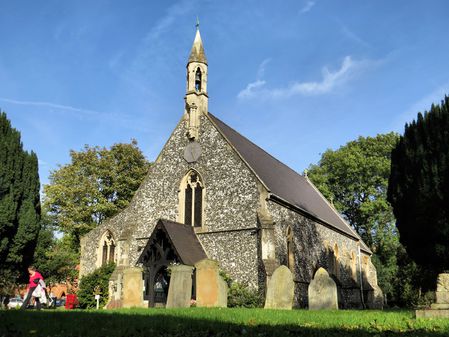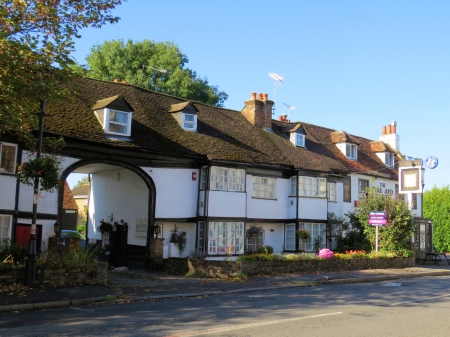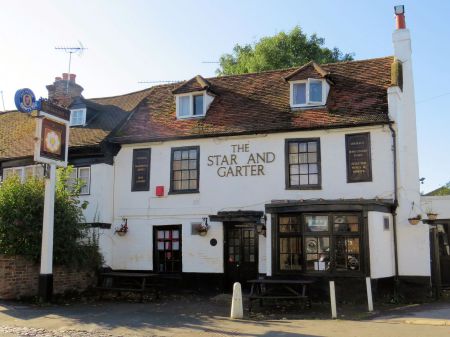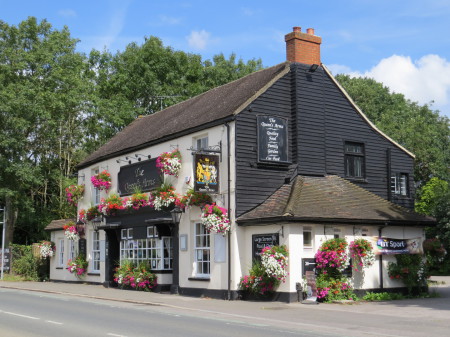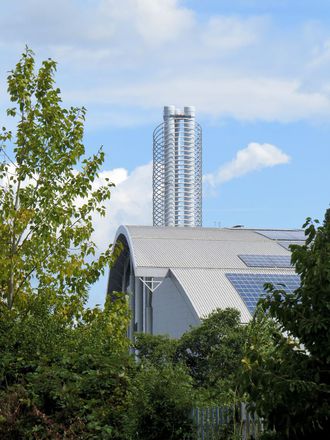
Note: Pages about areas of Slough such as this one are based on historic or accepted common usage rather than the artificial boundaries of the wards as set up by the Local Government Boundary Commission.
Colnbrook and Poyle
Colnbrook was known as Colebroc meaning ‘cool brook’ and was mentioned in the Domesday Book of 1086. In 1106 the Hospice was established and the name seems to have corrupted to the Ostrich Inn. In the 17th century one of its landlords was responsible for murdering sixty of his wealthy guests in order to steal their money.
The Ostrich Inn
On 11th November 1642, after the Battle of Edgehill, Charles I forces camped at Colnbrook and Parliament offered a petition of peace. Negotiations broke down and the Battle of Brentford commenced the following day. In 1664 the village was devastated by plague. The next plague left the village unscathed.
In 1825 Richard Cox produced the first Cox’s Orange Pippin apple tree in Colnbrook. In more recent times, Bruce McLaren based his Formula One racing car team in Poyle in the 1960s and 70s. Richard Cox, The Ostrich Inn and the McLaren stories are featured on their own pages. Click on a button below to open the page:
St Thomas’ Church was consecrated in 1852
Colnbrook and Poyle along with the village of Brands Hill forms the most easterly part of Slough. It is roughly an equilateral triangle in shape with the motorway M4 Junction 5, M25 Junction 14 and the combined M4/M25 Junctions 4b/15 at each point. The ward covers an area of about 2·1 square miles (5·5 square km). According to the 2011 census the population of Colnbrook and Poyle was 6,157. Colnbrook is mostly residential and Poyle largely given over to industry particularly in activities connected with the airport.
The airport is a big influence over the area, most obviously because of the aircraft noise. The airport also provides business for the trading estate areas. Other business is also attracted because of the nearby road transport links to the M25 and M4 motorways. Aircraft noise and busy industry is not what this ward of Slough is all about as many outsiders might think. Colnbrook and Poyle is quite a gem.
A British Airways Airbus A319 over Poyle
The Bath Road
The village really began to develop in the 16th century as a line of coaching inns for travellers along the old Bath Road. The present day Ostrich Inn and Ye Olde George, were built early in the 1500s. By 1577 the village had ten inns. Remarkably, at time of writing there are five pubs still on the route of the old Bath Road, the other three are the Queen’s Head, The Star and Garter and the Punchbowl. The buildings of the White Hart and the Royal Standard still exist but no longer operate as pubs. To complete this mini pub guide, to the south the Golden Cross is at the end of Poyle Road.
Ye Olde George Inn
In 1727 the Colnbrook Turnpike Trust was established and the Bath Road was made a turnpike through the village with a toll house built opposite Poyle Road. The village was important as a junction for coaches from London to Windsor. In 1929 the Colnbrook Bypass was fully opened to traffic to take pressure off the narrow High Street.
Listed buildings
For its size, Colnbrook and Poyle is rich in listed buildings having thirty-six within the ward. That represents about two-fifths of the total number in the whole of Slough. They are all Grade II except two, The Ostrich Inn and King John’s Palace, which are Grade II* listed.
King John’s Palace
King John’s Palace is an old manor house dating from about 1600 and is a Grade II* listed building. It was at some point divided into six apartments and it was occupied by pilots in the Second World War. It lies on ground where King John is thought to have stayed on his way to sign the Magna Carta at nearby Runnymede in 1215. This may account for the buildings’ name.
Water pump
In modern times a plaque has been fitted to this Grade II listed water pump on the Old Bath Road. It falsely claims ‘This pump was erected by order of ‘Beau’ Nash of Bath in 1754’. A new plaque fitted to the ground at its base sets the record straight. It reads: ‘The Poyle Pump. Erected in 1827 by the Colnbrook Turnpike Trust. Restored in 1992. Contractor: CDS Construction Ltd.’
The Star and Garter is tacked onto the end of the of King John’s Palace and was built late 17th/early 18th century
Station House
Colnbrook railway station was opened by The Great Western Railway in August 1884 and was one of 5 stations on the line which ran between West Drayton and Staines. It closed to passengers in March 1965 as a result of the Beeching report. Oil tanker trains still ran through to Staines until 1981 when the line was severed by construction of the M25. The rails still run right up to the pavement on the Old Bath Road.
Station House
Not only has Colnbrook retained many attractive listed buildings, it’s more modern residential developments are attractive too. There are no super rich residential areas here but there are certainly no ghettos either. The modern parts of the village are generally well-thought out and designed, very clean and well-kept just like the village as a whole. If Colnbrook was anywhere else it would attract tourists and support three or four gift shops and half a dozen tea rooms. I admire the place for surviving the pressures of the modern world largely on its own terms.
The village has four parks two of which, Colnbrook Recreation Park and Pippins Park, have been awarded Green Flags. Colnbrook Recreation Park is on the north side of the Bath Road next to the Queen’s Arms public house and features a football pitch, an enclosed area for toddlers and a zip wire among other things. Crown Meadow is on the opposite side of the road and is a Wildlife Heritage Site.
The zip line in Colnbrook Recreational Ground
Albany Park is on the north side of Park Street and features three benches in the shape of the letters C, O and X in honour of Richard Cox, the horticulturalist who in 1825 produced the Cox’s Orange Pippin apple tree. Pippins Park is named after the apple and features a basketball court and a tennis court.
Energy from Waste
A joint venture owned by Grundon Waste Management and Viridor, the Energy from Waste (EfW) facility on the Lakeside Industrial Estate is an incinerator used to destroy waste that would otherwise have gone straight for landfill. The plant became fully operational in January 2010 and is capable of incinerating over 400,000 tonnes of waste each year. In the process, it produces 37 megawatts of electrical power which, according to some sources, is enough to supply the domestic needs of 70-80,000 homes.
The distinctive twin chimney of Energy from Waste
Trade and industry
There are three trading areas in Colnbrook and Poyle, all of them along the eastern side bordering Heathrow Airport: Lakeside Industrial Estate is north of the A4; Colnbrook and Galleymead Roads are between the A4 and the old Bath Road; and the collection of individual business parks in Poyle south of the old Bath Road.
SEGRO
Industrial land owners SEGRO own two industrial areas in Poyle. Poyle 14 is located near to Junction 14 of the M25 motorway. The numbering is a coincidence of the area; Poyle 14 refers to the number of units built on the site. Riverside Cargo Centre is situated in Mathisen Way.
My name is Gary Flint. I'm author, photographer & illustrator for Postcards from Slough. If you wish to make any comments on the contents of the website please click on the ladybird below:
Gary Flint
08/03/1961 - 09/04/2019
Postcards from Slough is an independently funded website. We are open to offers of sponsorship from companies that have any connections to the town. To contact us please click on the ladybird below:
Chalvey Community Forum
Postcards from Slough is linked with a local action group the Chalvey Community Forum. The group liaises with various local organisations in order to improve the quality of life for residents in the ward of Chalvey and Salt Hill. To learn more please click on the maidenhair leaf below:
Museum of Berkshire Aviation
I volunteer as a guide at the Museum of Berkshire Aviation. It is a special museum and if you would like to know more about the museum then please click on the motif below:
To learn more about the museums activities while staying within this website click on the tab at the top of the page or on the motif below:
Graces Guide
Postcards from Slough uses some images from Grace's Guide. Click on the button below:
British Listed Buildings
Postcards from Slough contributes material to British Listed Buildings and uses the site for cross referencing purposes. Click on the button below:

